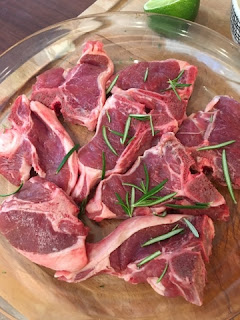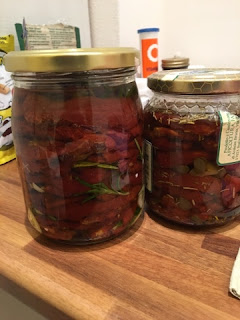Typical or "tipico" dishes would be Tagliatelle with ragu, tortellini con brodo, tortellini con burro e salvia.
The ragu is a mix of ground beef, ground pork and spices with olive oil (no tomatoes). Tortellini comes from one place locally-Valegio- unless you make your own. Valegio makes amazing pasta and imports their Tortelloni and tortellini into the city fresh daily. All the small markets carry it in bulk and you can buy it by the serving. You have to be able to describe how you will serve it, with broth (con brodo) or as a primi (first course) with butter and sage. Both are local specialties.
A disclaimer on the photo below. It is not a typical dish with Tortelloni. It was explained to me after I sent this photo to our friends, that you are only to use the tiny tortellini in soup. It sure did taste good as pictured though!
Lamb is very prevalent here in spring. We have had it several times in several dishes. I'm looking forward to braising some lamb shank soon.
There is a lot of condiment use here, all from local produce. Sun dried tomatoes in oil, black olive pate, olives, pepperoni (here it means roasted red and yellow peppers in oil).
My first experiment was with reconstituting sun dried tomatoes. I had tried many times at home to do this with mixed results, usually too salty or too leathery. I followed the instructions of a local and came up with the best marinated sun dried tomatoes ever. The secret is to cook them briefly in a mix of white wine and water (50/50), then lay them out to dry on paper towels for about an hour. After that you layer them in a jar with your choice of herbs, thin slices of garlic, capers etc. The finished product is ready to eat in 24 hours and after the tomatoes are gone, the oil is divine for dipping crusty bread.
One evening we were invited upstairs for dinner with our friends parents (they live just above us). It was a Calabrian meal- her father is from the south. The antipasti included a black olive spread they called pate. I asked our friend Chaira if she could give me the recipe and she says "my mother will teach you". Two days later the doorbell rings- here is Chiara's mum with a big jar of black olives in hand. She gestures upstairs and I follow her up. In the kitchen she takes out a blender and two paring knives. We sit in companionable silence as we pit the entire jar of olives into the blender jar. She then adds three large cloves of garlic, peeled and quartered. She gets a bottle of olive oil from a cabinet full of bottles- all different sizes and shapes- the oil comes from a local collective they belong to so no labels. Into the blender goes a big glug of the oil- probably at least a cup. Pulse, pulse, whirl- add more oil from the top. Pulse, pulse, whirl and by the time we are done she has added about 1/2 liter in total. The pate is smooth as silk and fragrant from the olives and garlic. She spoons some of into a small jar for me and sends me back home. Since she doesn't speak English and my Italian is still very bad we don't converse much, but the companionship was wonderful and the cultural exchange will be a bright memory for me.
Every day I look for something new or an old favorite with fresher ingredients. I'm sure there will be more food posts in the future.







